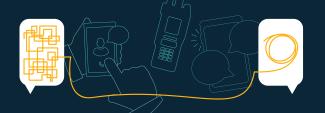This blog is a repost from Mission Critical Communications, originally published in the 2021 International Wireless Communications Expo (IWCE) Show Edition.
This year marks the 20th anniversary of the terrorist attacks on September 11. In the aftermath of that tragedy, the public safety community pushed for its own dedicated network to address some of the communications challenges responders faced on that day. The community called for a nationwide network, one it could rely on to communicate and share information with each other during emergencies as well as their day-to-day operations.
In the two decades since September 11, the way we communicate has changed. Smartphones are commonplace, and we use apps to help us with everything from ordering groceries to mapping out trips and consulting with our doctors. Public safety is also seeing the benefits of the wireless broadband revolution thanks to advancements in mobile data technologies.
The First Responder Network Authority (FirstNet Authority) was established to deploy a nationwide broadband network for public safety communications and deliver innovative solutions that are proven to meet first responders’ communications needs. The FirstNet Authority continuously works with public safety across the country to evolve the FirstNet network. In March 2017, we announced that AT&T had won the competition to be our commercial partner to build and deploy FirstNet. According to their latest earnings announcement in July, FirstNet provides wireless broadband communications to more than 17,000 public safety agencies and organizations comprising over 2.5 million connections on the network.
One of the key capabilities that public safety requested during the planning phase of FirstNet was the ability to determine the Z-axis, or vertical axis, location of personnel. This was stressed to be a must-have service provided by their network. The FirstNet Authority is proud to say that this service is now available in a growing number of areas on the FirstNet network for the nation’s first responders.
XY and Z Axis
Imagine a call for disturbance from inside a multistory building, and two officers respond to the scene. The officer who arrives first enters the building and reports shots fired. The arriving second officer and dispatch both track the location of the first officer, without voice prompts, to the fourth floor. The second officer goes immediately to the scene for backup.
The new vertical location services available to FirstNet subscribers will help with responses in those scenarios. FirstNet’s Z-axis capability provides first responders with enhanced situational awareness not available with traditional GPS. In addition to latitude and longitude coordinates, Z-axis provides a vertical location to help locate personnel in tall buildings.
How Z-axis Works
FirstNet’s Z-axis capability is the next evolution of FirstNet Enhanced Location Services (ELS), designed to assist with identifying where a first responder is located within a building. Z-axis location data provides the first responder with the vertical reference point in terms of height above terrain (HAT) to indicate the relative altitude or vertical location of the first responder and their team members. Z-axis uses the barometric sensor built into most smartphones to measure HAT.
The data is accessed using a vertical positioning service available to public safety app developers, which is the first such service to be offered to public safety and is exclusively available to FirstNet subscribers. The service is currently available in more than 100 major metropolitan areas across the U.S. with additional markets added on a regular basis. To find a Z-axis situational awareness app, you can check the FirstNet App Catalog. The FirstNet App Catalog identifies public-safety apps that have undergone a rigorous vetting and approval process to ensure apps are relevant to public safety, have enhanced security and privacy features, and demonstrate reliability.
With just a FirstNet-enabled smartphone and app, public safety entities can now track the in-building vertical location of personnel, not just vehicles, without verbal input. This has important benefits for many public safety disciplines.
Z-Axis and the ECC
In emergency communications centers (ECC), Z-axis capability helps telecommunicators know when to dispatch additional units or determine what type of equipment to send to the scene.
With X and Y location-based services, telecommunicators can track a responder’s movement, speed, direction and orientation. Now with XY and Z coordinates, they can also see the height location of a responder in a multistory building or other structure like a parking garage. Through apps, first responders can share their location with their teams on scene and with commanders, incident managers and dispatchers.
Eddie Reyes is director of the Department of Public Safety Communications in Prince William County, Virginia, which provides command, control and information support services to police, fire and rescue services. Reyes understands all too well that location accuracy saves lives.
“In 9-1-1, we have to keep track of not only the location of the caller’s emergencies but also the first responders,” he says. “Location accuracy is quite possibly the most important thing we focus on every single day. From a budget and time perspective, I can’t think of another technology that takes more than location accuracy because locating people in an emergency is our highest priority. Seconds count when somebody needs help. So that’s why location accuracy is just so important in the 9-1-1 industry.”
Z-Axis and Law Enforcement
Before his current role, Reyes retired as the senior deputy chief of the Alexandria Police Department in Virginia after more than 25 years of service. He also understands the importance of Z-axis location capabilities to law enforcement.
“Just like we need to know where law enforcement vehicles are in an emergency, the next step is knowing where law enforcement officers are,” he said. “Because oftentimes, if the officer separates from the vehicle like in a foot chase through a multilevel structure, you need to know where that officer is. So Z-axis capability is always going to be very important because it extends location accuracy to the person and not just the vehicle.”
Location-based services, including the Z-axis or vertical location, have many potential benefits for law enforcement:
- Officer safety. An officer’s exact location, including how high in a high-rise building, is available to team members and dispatch without verbal cues.
- Coordination. When responding to an incident, officers can see the location of other officers during the call for service and coordinate their response.
- Effective search operations. Incident command can track officers in a building search and can locate all officers when establishing a perimeter.
- Insight into past events. In a post-incident review, an officer’s movement and path can be examined to recreate the scene.
Harry Markley is a subject matter expert for law enforcement at the FirstNet Authority. He sees great promise for vertical location services for officers in the field.
“Situational awareness for law enforcement is everything,” he says. “The more information officers have about the surrounding environment helps them make better decisions to keep everyone safe and complete the mission.”
Z-Axis and the Fire Service
One of the most challenging and dangerous situations for a firefighter is being disoriented or lost in a burning building. This can happen when firefighters lose visibility due to heavy smoke, get separated from their crew, suffer an injury or encounter a collapsed structure. While every fire emergency is taxing and unpredictable, fires in multistory buildings take these risks to new heights.
In environments of extreme heat, smoke and low visibility, FirstNet’s Z-axis capability helps locate personnel quickly, efficiently, and without voice prompts.
Chief Harlin McEwen, a leading voice for public-safety broadband and an expert in emergency communications, lauds the advent of Z-axis location services.
“The Z-axis solution is really exciting, particularly for the fire service,” he says. “If they’re trapped in a building while fighting a fire and get disoriented and can’t find their way out, it’s critical that the command structure on the street is able find them with some kind of expertise. Vertical location is something that we’ve been talking about a long time. The fact that now the FirstNet Authority and AT&T have come together to offer this solution is a big deal.”
The FirstNet Authority understands the importance of situational awareness to first responders. In our discussions with public safety, first responders emphasized the need for location-based services and mapping tools to help track personnel and assets. That’s why we’ve made situational awareness a priority for FirstNet.
As with any emerging technology, Z-axis capability is an evolutionary service that will continue to grow to meet public safety’s needs. The public-safety community will validate Z-axis capability in everyday real-world settings. When evaluating Z-axis capability, public safety will be looking at performance, the operating environment, the generation of 3D maps, device types and capabilities, and integration with other tracking systems.
The FirstNet Authority will continue to work with experts from industry, researchers in academia and our partners at AT&T to evolve location-based services for public safety. So, the officer responding to shots fired, the firefighter disoriented in a burning building, and the dispatcher sending backup all have the lifesaving tools they need to locate personnel and communicate and share information.




















